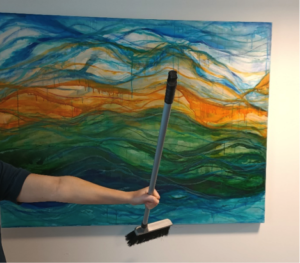
Tennis elbow, also known as lateral epicondylalgia, is when pain develops around the bone on the outside of the elbow. Golfers elbow, medial epicondylalgia, is similar, but on the medial side of the elbow.
Tennis elbow is caused by overloading, or overuse of the extensor muscles of the forearm. Causes can include (not just tennis!):
- Repetitive upper limb activities
- Computer use
- Heavy lifting
- Repetitive vibration
- Racket sports
- Throwing sports (Physiopedia, 2019)
The common extensor tendon is usually affected, in particular a muscle called extensor carpi radialis brevis. This muscle holds the wrist still during gripping movements and hand function (Bisset, 2019). It is a tendon problem, so joints are not involved.

How do you diagnose it?
If you see a Doctor or Physiotherapist, they do an assessment to rule out other causes of your symptoms. Commonly, people report:
- Pain on the outside of their elbow around the lateral epicondyle (without referred pain)
- Pain with gripping or picking things up
- History of overloading/overuse and a gradual onset – the amount of overload which causes pain would vary person to person (Bisset, 2019).
You do not usually need a scan to diagnose tennis elbow. On ultrasound, there can be tendon degeneration with tennis elbow. However, this is also seen on asymptomatic people, and therefore is a normal ageing process (Bisset, 2019).
What can I do?
- Avoid aggravating activities or positions – if you cannot totally avoid these, try changing position regularly, or have mini breaks
- Lift with the palms facing up
- Exercise pain free range only
What can a Physio do?
We can prescribe an exercise program specific to your level of fitness and injury which is what will help you recover from tennis elbow and help prevent it from returning. This will be progressed and changed as your injury improves. Physio treatment can release tight muscles or joints that maybe contributing to the injury. We can also strap your elbow or fit a brace which can give pain relief. This is an example of two exercises that can help tennis elbow.
Isometric exercises:
You can try these exercises holding a broom or stick you have at home (not heavy). You should aim to hold for 3×30 seconds, a few times daily. Do not force through pain. This is a static muscle contraction, so there isn’t any movement. One is pronation (palm facing down), the other is supination (palm facing up).


Eccentric elbow extension exercise:
Try this pain free range (shouldn’t flare up that evening or next morning), and every second day.
https://www.youtube.com/watch?v=DAwG2z0p58I
Differential diagnoses include:
- Posterior interosseous syndrome
- Elbow osteoarthritis
- Fractures – associated with trauma
- Neck pain with referred nerve root pain
- Fibromyalgia
- Golfers elbow
A Physiotherapist or Doctor can help rule out other causes of the pain.
Notes for Physios:
Bisset (2019) suggested that rest (avoiding aggravating factors) should be for 6-8 weeks. If it is not improving, start exercising and strengthening the tendons after this point.
Exercising in to pain does not help symptoms (Bisset, 2019).
You can use pain free grip strength (PFGS) as an outcome measure for improvement rather than maximal grip strength (Bisset, 2019).
Manual therapy can change pain e.g. mobilisations with movement during gripping (Bisset, 2019). Bisset provided a second podcast for treatment of lateral elbow pain on the clinical edge website – www.clinicaledge.co
References:
Bisset, L. 2019. Lateral Elbow Pain. [online]. [Accessed 30th August 2019]. Available from: http://www.clinicaledge.co
Physiopedia. 2019. Lateral Epicondylitis. [online]. [Accessed 30th August 2019]. Available from: http://www.physio-pedia.com
OUR PHYSIOS

Georgina Gardner
BHSC (Physio), PGDIP (MSK)
Georgina graduated from AUT in 2015 and has worked in private practice since then. She also completed her Post Graduate Diploma in Musculoskeletal Physiotherapy in 2020 and has focused her skills on Musculoskeletal Physiotherapy ever since.
full bio +
Alfred Vondermann
BHSc Physio
Alfred has a keen interest in providing quality musculoskeletal physiotherapy to both the general public and athletes. Alfred is well practiced in exercise prescription, soft tissue therapy techniques and acupuncture.
full bio +
Josh Kronfeld
BHSc Physio
Josh is more famously known as an All Blacks legend! He has a keen interest in musculoskeletal injuries and also practices acupuncture.
full bio +
Janaka Radich
BHSc (Physio) MPNZ, COMT
Janaka specialises in treating sporting and complex spinal injuries and has a keen interest in manual therapy and acupuncture completing post-graduate courses in osteopathic manipulation and muscle energy techniques.
full bio +
Helen Edwards
BHSc (Physio), PGCert (Western Acup)
Helen has practiced in the private sector for the past 8 years and has extensive experience in specialty areas including sporting injuries, spinal dysfunction, Pilates, pregnancy and post-natal assessment, treatment and rehabilitation.
full bio +







